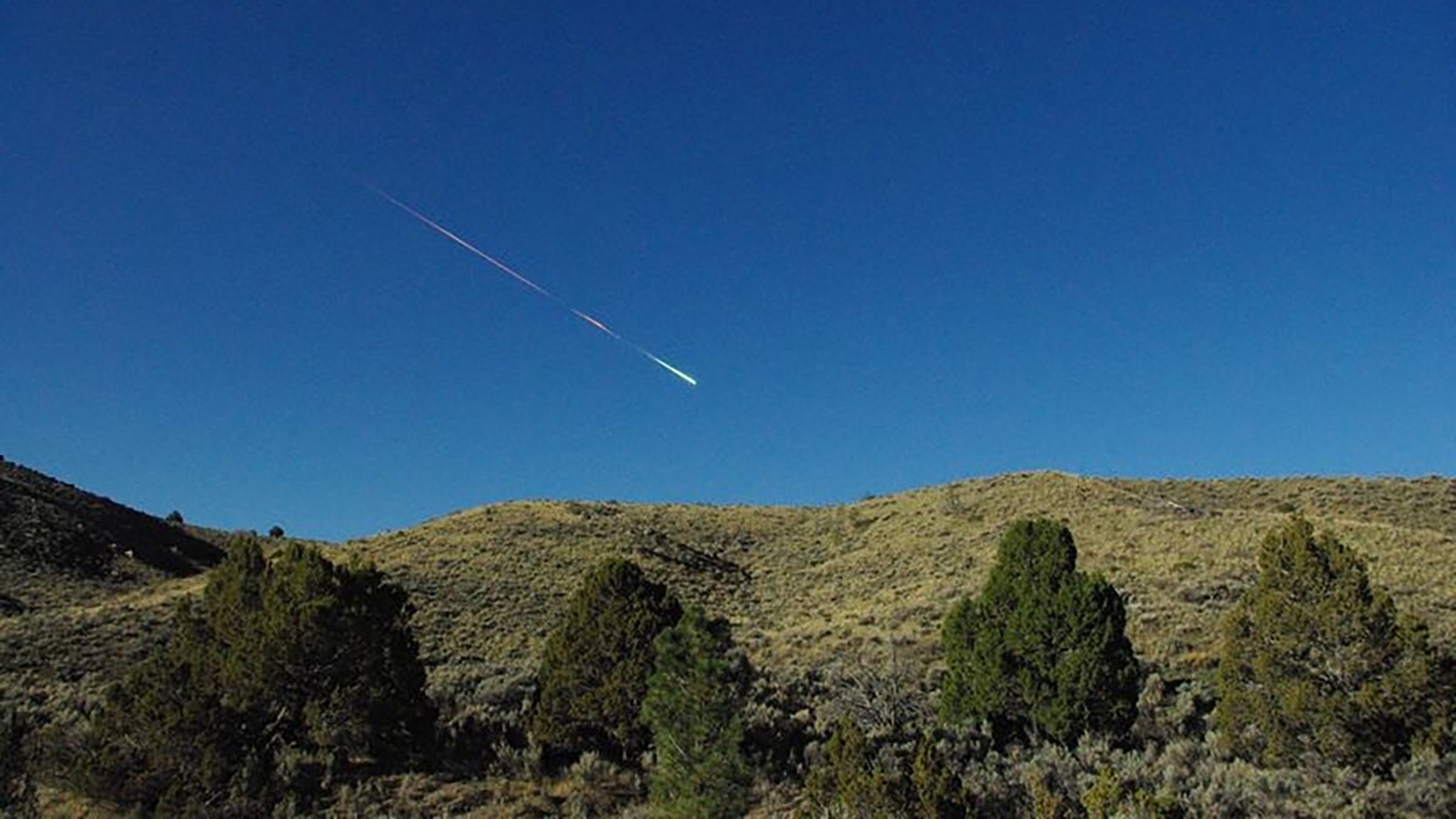A meteorite that created the fireball that blazed over Dubois on Monday could mean a heck of a payday for whoever may be lucky enough to find a piece of it — wherever it landed.
The American Meteor Society (AMS) received two reports at about 2:45 p.m. Monday of a blueish-green fireball with a white tail in the skies over Wyoming.
A pair of Cowboy State Residents who were identified by AMS simply as Steve M. of Jackson and Sinead S. of Dubois each reported the meteor, with Sinead saying it was “the craziest thing I (had) ever seen and so fast and beautiful.”
Numerous reports also were made to the AMS from several communities in Montana and Idaho around the same time. Each report was probably for the same fireball seen from Dubious and Jackson.
Great Ball Of Fire
AMS defines a fireball as “a very bright meteor, generally brighter than magnitude -4, which is about the same magnitude of the planet Venus in the morning or evening sky.”
It’s estimated that thousands of fireballs happen in the Earth’s atmosphere every day, but they are rarely bright enough to be seen.
What made Monday’s fireball unique was that it was bright enough to be spotted during the peak daylight of the afternoon. That means it must’ve been at least magnitude -6, brighter than Venus and around half as bright as the moon.
Markings and Metals
Max Gilbraith, planetarium coordinator for the University of Wyoming Physics and Astronomy Department, said fireballs aren’t uncommon in Wyoming’s skies. But meteorites, a fragment of a meteoroid or asteroid that makes it through the atmosphere and lands on the Earth’s surface are rare in the region.
“Meteor finds are particularly rare in mountainous areas,” he said. “Most are found in snowfields and deserts, like Antarctica. It’d be incredibly difficult, if not impossible, to find a meteorite in the mountains, since the surface area is incredible and there’s large amounts of rocks and trees and loose stuff on the surface.”
The fireball may be associated with the Orionids, annual meteor showers that last about a week in late October, he said. This year’s Orionids peaked Oct. 22, with an average of 58 meteors seen every hour.
Most people would encounter a meteorite as an oddly discolored rock, but Gilbraith said there are other telltale signs of meteorites.
Fresh meteorites have a distinct crystalline pattern that looks like rust but is etched into its surface. They are also covered with a black “fusion crust” of plasma charred material formed from the heat of traveling through earth’s atmosphere, he said.
Meteorites also are radioactive, especially when they’ve just landed on the surface. But Gilbraith doesn’t think there’s enough radiation with this one to pose a serious risk in the unlikely event it, or any piece of it, were to be found.
“There’s a bit of a higher radiation level, but I don’t think it’s worse than eating a banana,” he said.
They Can Be Valuable
Meteorites are made of a mix of stone and iron, but they also contain a high concentration of the elements nickel and iridium, which is one of the most corrosion-resistant naturally occurring metals. This makes meteorites one of the most valuable substances on earth, depending on their composition.
As of Tuesday, an ounce of iridium was selling for $5,000.
Fireballs aren’t uncommon in the Rocky Mountain Region, and the one spotted Monday was bright enough to be seen in the afternoon sky. But was it bright enough to land on the earth’s surface and be worth a fortune to the lucky finder?
Finders Keepers?
The fireball seen over Dubois may have landed as a meteorite, but there’s no way to know for sure. According to the AMS, fireballs must have a magnitude of at least -8 to -10 to land as meteorites.
In fact, the spectacular sight of the fireball could be evidence that it didn’t land as a meteorite. The colors and long white tail of fireballs are caused by its surface disintegrating and burning away in the atmosphere.
If Monday’s fireball landed as a meteorite, the hardest part of collecting it would be finding it, considering that it was seen as far north as Big Sky, Montana. If it landed, there’s no way of telling where it is, Gilbraith said.
Meteorites can be collected on public lands. For instance, the BLM allows the collection of meteorites up to 10 pounds in size near developed recreation sites and certain units of the National Landscape Conservation. Collecting in wilderness areas is prohibited, and using motorized and mechanical equipment is prohibited.
“It’s going to vary by the state and the type of land,” Gilbraith said. “I know there are certain areas in national parks, forests and monuments where collecting any rocks is prohibited. But in some places, you can. You got to check first.”
Also, meteorites collected on public lands cannot be sold commercially. So, no $5,000 paydays for BLM space rocks.
The Real Reward
The fireball may have landed as a meteorite, but it will likely never be found. But in Gilbraith’s view, seeing any fireball is an accomplishment.
“They do happen fairly often, but you have to be lucky to see them,” he said. “The average person might only see one in their whole life.”
He also has advice for anyone who thinks they have what it takes to find fallen meteorites in the mountainous terrain of Wyoming.
“I’d get a lotto ticket if you’re feeling that lucky,” he said.
Andrew Rossi can be reached at arossi@cowboystatedaily.com.





